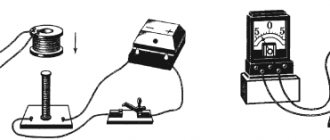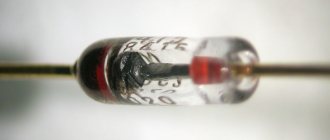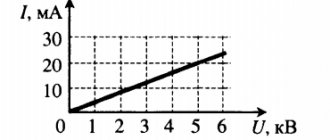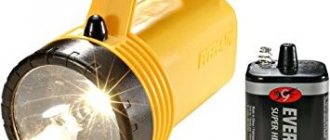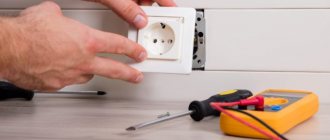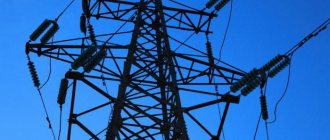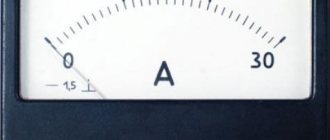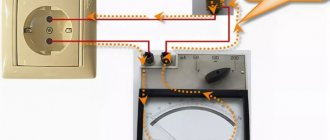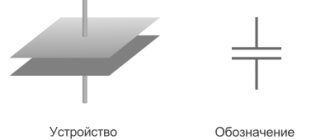Electric current is the directed (ordered, that is, not chaotic) movement of electrically charged particles or charged macroscopic bodies. Charged particles usually mean electrons or ions, and macroscopic particles (visible to the naked eye) mean large particles, such as charged raindrops. Current occurs in the presence of an electric field. Let's figure out how the direction of electric current is determined.
Electric current in different substances
Electric current occurs in a variety of substances, which can be in different states of aggregation. Let's consider some examples demonstrating the occurrence of a directed flow of charged particles in solid, liquid and gaseous media:
- Metals have many free electrons, which are the main source of current;
- Electrolytes are liquids that conduct electrical current. Aqueous solutions of acids, alkalis, and salts are all examples of electrolytes. When molecules of these substances enter water, they disintegrate into ions, which are charged atoms or groups of atoms that have positive (cations) or negative (anions) electrical charges. Cations and anions form an electric current in electrolytes;
- In gases and plasmas, current is created by the movement of electrons and positively charged ions;
- In a vacuum - due to electrons escaping from the surface of metal electrodes.
Rice. 1. Examples of electric current in different substances (metals, electrolytes, gases, plasma, vacuum).
In the examples given, currents arise as a result of the movement of charged particles relative to a particular medium (inside bodies). This current is called conduction current. The movement of macroscopic charged bodies is called convection current. An example of convection current is raindrops during a lightning strike.
The direction of current in a conductor, how, where and where electric current flows in conductors.
Electric current is the ordered movement of charged particles. In solids this is the movement of electrons (negatively charged particles); in liquid and gaseous bodies this is the movement of ions (positively charged particles). Moreover, current can be constant or alternating, and they have completely different movements of electrical charges. In order to well understand and master the topic of current movement in conductors, perhaps you first need to understand in more detail the basics of electrophysics. This is where I will start.
So how does electric current flow in the first place? It is known that substances consist of atoms. These are elementary particles of matter. The structure of the atom resembles our solar system, where the nucleus of the atom is located in the center. It consists of protons (positive electrical particles) and neutrons (electrically neutral particles) tightly pressed together. Around this nucleus, electrons (smaller particles with a negative charge) rotate in their orbits at tremendous speed. Different substances have different numbers of electrons and the orbits in which they rotate. The atoms of solids have what is called a crystal lattice. This is the structure of a substance in which atoms are arranged relative to each other in a certain order.
Where can electric current arise here? It turns out that in some substances (current conductors), the electrons that are furthest from their nucleus can break away from the atom and move to a neighboring atom. This movement of electrons is called free. Electrons simply move within a substance from one atom to another. But if an external electromagnetic field is connected to this substance (electrical conductor), thereby creating an electrical circuit, then all free electrons will begin to move in one direction. This is precisely the movement of electric current inside a conductor.
Now let's figure out what direct and alternating current are. So, direct current always moves in only one direction. As stated at the very beginning, electrons move in solids, and ions move in liquid and gaseous bodies. Electrons are negatively charged particles. Consequently, in solids, electric current flows from minus to plus of the power source (electrons move along the electrical circuit). In liquids and gases, current moves in two directions at once, or rather, simultaneously, electrons flow to the plus, and ions (individual atoms that are not interconnected by a crystal lattice, they are each on their own) flow to the minus of the power source.
It was officially accepted by scientists that the movement occurs from plus to minus (the opposite of what happens in reality). So, from a scientific point of view it is correct to say that the electric current moves from plus to minus, but from a real point of view (electrophysical nature) it is more correct to believe that the current flows from minus to plus (in solids). This was probably done for some convenience.
Now, as for alternating electric current. Here everything is a little more complicated. If in the case of direct current the movement of charged particles has only one direction (physically, electrons with a minus sign flow to the plus), then with alternating current the direction of movement periodically changes to the opposite. You've probably heard that a regular city electrical network has an alternating voltage of 220 volts and a standard frequency of 50 hertz. So these 50 hertz indicate that in one second the electric current manages to go through a full cycle having a sinusoidal shape 50 times. In fact, in one second the direction of the current changes as many as 100 times (it changes twice in one cycle).
PS The direction of current in electrical circuits is important. In many cases, if the circuit is designed for one direction of current, and you accidentally change it to the opposite direction or connect alternating current instead of direct current, then most likely the device will simply fail. Many semiconductors that work in circuits can break through and burn out when the current flows in the opposite direction. So when connecting the electrical power, the direction of the current must be strictly observed by you.
In which direction does the current flow?
The direction of movement of positively charged particles is taken as the direction of the current; if the current is created by negatively charged particles (for example, electrons), then the direction of the current is considered opposite to the direction of movement of the particles.
Rice. 2. Direction of current flow for any electrical circuit.
The question arises: why was the obvious direction option, coinciding with the direction of electron motion, not accepted? In order for this to become clear, we need to dive a little into the history of physics.
General information
The basis of the physical body is its crystal lattice. It consists of nodes called atoms. These, in turn, include positively charged protons and neutrons. Electrons rotate around the nucleus in orbitals. These are particles that have a negative charge. There is a connection between the parts of the lattice. It is caused by electrical forces.
The energy state of the body, which is not affected by external influence, can be described as equilibrium. That is, the charges possessed by electrons and protons cancel each other out. But along with this, free particles exist in various bodies called conductors. They are electrons that have no connection with atoms.
If the body is not affected, negatively charged particles move chaotically in the body. No forces or phenomena are detected. But if an external influence is applied to the body, for example, it is deformed or brought under the influence of an electromagnetic field, the chaotic movement of electrons turns into ordered. Free charge carriers begin to move in one direction, thereby changing the potential at points. Electric current appears.
This value is described by two characteristics:
- scalar - current strength;
- vector - current density.
In the International System of Units, current is measured in amperes (A). It depends on the potential difference and the resistance of the body to the flow of charge carriers. Essentially, it is determined by the ratio of the number of charged particles passing through the cross section of the material per unit time: I = ΔQ / Δt. The current density determines the value of the force flowing through a unit surface: j = I / S.
If the current does not change in value over time, it is called constant. Otherwise - variable. For the second type, they also say that the current flows according to a harmonic law. Most often, a sine function is used to describe alternating current. A constant signal arises from galvanic cells or dynamos, and an alternating signal is produced by generators.
Why you need to know the history of physical discoveries
Many researchers tried to explain the nature of electrical phenomena long before the discovery of the electron (1897). For the first time, the American physicist Benjamin Franklin came to understand the existence of two types of charges - positive and negative - in 1747. Based on his observations, he suggested (hypothesized) that there is some kind of “electrical matter” consisting of small, invisible particles. He was the first to introduce the designation for electric charges “−” and “+”. Franklin proposed that if a body is filled with electrical matter, then it becomes positively charged, and if it loses electricity, then it becomes negatively charged. If the circuit is closed (connected), the positive charge will flow to where it does not exist, that is, to the “minus”. This fruitful hypothesis became popular, gained recognition among scientists, and was included in reference books and textbooks.
Of course, after the discovery of a negatively charged electron, this “inconsistency” between the real direction of motion and the previously generally accepted one was discovered. However, the global scientific community decided to leave in force the previous formulation about the direction of the current, since in most practical cases this does not affect anything.
If necessary, to explain individual physical effects in semiconductors and artificial materials (heterostructures), the current direction of electron motion is taken into account.
Benjamin Franklin is also famous as an outstanding politician, diplomat and writer. He is one of the authors of the US Constitution. In recognition of Franklin's service, the $100 bill has featured his portrait since 1914.
Rice. 3. Image of a 100 US dollar bill with a portrait of Benjamin Franklin.
Types of currents: constant and variable
Depending on the change in the direction of flow of charged particles, the following types of currents are distinguished:
- Constant - formed by the movement of charged particles in one direction. Its main characteristics (current strength, voltage) have constant values and do not change over time;
- Variable - the direction of movement of charges with this type of movement of charged particles periodically changes. The number of changes in the direction of movement per unit time equal to one second is called the frequency of the current and is measured in Hertz. For example, the value of this characteristic in a typical household electrical circuit is 50 Hz. This means that within 1 second, electrons moving along the circuit change their direction 50 times, thereby causing the same number of voltage changes in the phase wire from 220 to 0 V.
The importance of electron movement in an electrical circuit
Understanding how current flows in a circuit is necessary when drawing up a graphical representation of the arrangement of electronic parts, such as a diagram. It is important to understand where the current flows from in order to correctly position on the circuit and then connect various radio-electronic elements. If for such radio components as a capacitor, resistor, the polarity of the connection does not matter, then a semiconductor transistor,
The diode must be placed on the circuit and then powered, taking into account the direction of current flow, otherwise they and the device assembled using them, the electronic unit, will not function correctly.
Thus, knowledge of the physical essence of the direction of flow of charged particles in a conductor, electrolyte, semiconductor will allow anyone not only to expand their horizons, but also to apply it in practice when installing electrical wiring, soldering various electronic components and circuits. Also, such information will help you understand why a breakdown of an electrical appliance occurred, how to fix it and prevent it in the future.
Direction of electric current
The direction of the electric current is usually considered to be from plus to minus of the generator or power source, and it is assumed that it flows in metal conductors. However, I is formed not only in conductors, but also in gases and liquids. Metal atoms are bound into a strong crystal lattice, so only free electrons can move freely; ions remain motionless. Atoms of gases and liquids can move freely because they do not have strong bonds. Consequently, ions and electrons serve as charge carriers.
Therefore, when determining the current strength I in gases and liquids, it is necessary to take into account the sum of positive and negative charges passing through the cross-sectional area per unit time. For example, in a metal conductor I = 1 A , if 6.28 18 electrons (1 C) pass through the conductor in one second.
One ampere in a gas or liquid can form 3.14 18 electrons (0.5 C) and the same number of positive ions (another 0.5 C). If the charge of the ion is twice the charge of the electron, then half as many ions will be needed to create one ampere.
Direction of electric current in conductors
Historically, the direction of flow of electric current was taken from “plus” to “minus”, that is, from the positive to the negative electrode of the power source. In fact, if we consider a metal conductor, the electrons, which are the only charge carriers, move from the negative electrode to the positive one. Therefore, the actual direction of the current is opposite to the accepted one.
This direction was proposed by Benjamin Franklin due to the lack of knowledge at that time about the nature of electric charge carriers in conductors. Benjamin Franklin's portrait appears on the one hundred dollar bill.
Direction of electric current in gases and liquids
In gases and liquids, electric current can flow from plus to minus, according to the traditional view, since they can have a predominant number of positive ions. They did not change the direction to the “correct” one, since it had become too commonplace.
Source
